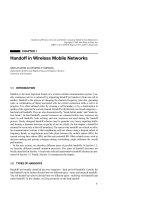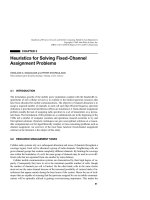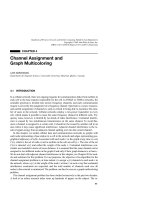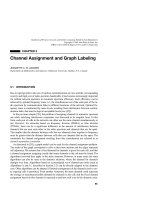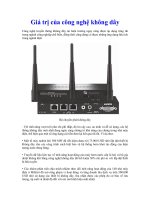Tài liệu Sổ tay của các mạng không dây và điện toán di động P6 ppt
Bạn đang xem bản rút gọn của tài liệu. Xem và tải ngay bản đầy đủ của tài liệu tại đây (158.09 KB, 25 trang )
CHAPTER 6
Wireless Media Access Control
ANDREW D. MYERS and STEFANO BASAGNI
Department of Computer Science, University of Texas at Dallas
6.1 INTRODUCTION
The rapid technological advances and innovations of the past few decades have pushed
wireless communication from concept to reality. Advances in chip design have dramatical-
ly reduced the size and energy requirements of wireless devices, increasing their portabil-
ity and convenience. These advances and innovations, combined with the freedom of
movement, are among the driving forces behind the vast popularity of wireless communi-
cation. This situation is unlikely to change, especially when one considers the current push
toward wireless broadband access to the Internet and multimedia content.
With predictions of near exponential growth in the number of wireless subscribers in
the coming decades, pressure is mounting on government regulatory agencies to free up
the RF spectrum to satisfy the growing bandwidth demands. This is especially true with
regard to the next generation (3G) cellular systems that integrate voice and high-speed
data access services. Given the slow reaction time of government bureaucracy and the
high cost of licensing, wireless operators are typically forced to make due with limited
bandwidth resources.
The aim of this chapter is to provide the reader with a comprehensive view of the role and
details of the protocols that define and control access to the wireless channel, i.e., wireless
media access protocols (MAC) protocols. We start by highlighting the distinguishing char-
acteristics of wireless systems and their impact on the design and implementation of MAC
protocols (Section 6.2). Section 6.3 explores the impact of the physical limitations specific
to MAC protocol design. Section 6.4 lists the set of MAC techniques that form the core of
most MAC protocol designs. Section 6.5 overviews channel access in cellular telephony
networks and other centralized networks. Section 6.6 focuses on MAC solutions for ad hoc
networks, namely, network architectures with decentralized control characterized by the
mobility of possibly all the nodes. A brief summary concludes the chapter.
6.2 GENERAL CONCEPTS
In the broadest terms, a wireless network consists of nodes that communicate by exchang-
ing “packets” via radio waves. These packets can take two forms. A unicast packet con-
119
Handbook of Wireless Networks and Mobile Computing, Edited by Ivan Stojmenovic´
Copyright © 2002 John Wiley & Sons, Inc.
ISBNs: 0-471-41902-8 (Paper); 0-471-22456-1 (Electronic)
tains information that is addressed to a specific node, whereas a multicast packet distrib-
utes the information to a group of nodes. The MAC protocol simply determines when a
node is allowed to transmit its packets, and typically controls all access to the physical lay-
er. Figure 6.1 depicts the relative position of the MAC protocol within a simplified proto-
col stack.
The specific functions associated with a MAC protocol vary according to the system
requirements and application. For example, wireless broadband networks carry data
streams with stringent quality of service (QoS) requirements. This requires a complex
MAC protocol that can adaptively manage the bandwidth resources in order to meet these
demands. Design and complexity are also affected by the network architecture, communi-
cation model, and duplexing mechanism employed. These three elements are examined in
the rest of the section.
6.2.1 Network Architecture
The architecture determines how the structure of the network is realized and where the
network intelligence resides. A centralized network architecture features a specialized
node, i.e., the base station, that coordinates and controls all transmissions within its cover-
age area, or cell. Cell boundaries are defined by the ability of nodes to receive transmis-
sions from the base station. To increase network coverage, several base stations are inter-
connected by land lines that eventually tie into an existing network, such as the public
switched telephone network (PTSN) or a local area network (LAN). Thus, each base sta-
tion also plays the role of an intermediary between the wired and wireless domains. Figure
6.2 illustrates a simple two-cell centralized network.
120
WIRELESS MEDIA ACCESS CONTROL
User Application User Application
IP
Datalink
MAC Protocol
Network Interface
Application Layer
Transport Layer
Network Layer
Datalink Layer
Physical Layer
TCP UDP
Logical Link Control
Routing
Figure 6.1 Position of the MAC protocol within a simplified protocol stack.
Communication from a base station to a node takes place on a downlink channel, and
the opposite occurs on an uplink channel. Only the base station has access to a downlink
channel, whereas the nodes share the uplink channels. In most cases, at least one of these
uplink channels is specifically assigned to collect control information from the nodes. The
base station grants access to the uplink channels in response to service requests received
on the control channel. Thus, the nodes simply follow the instructions of the base station.
The concentration of intelligence at the base station leads to a greatly simplified node
design that is both compact and energy efficient. The centralized control also simplifies
QoS support and bandwidth management since the base station can collect the require-
ments and prioritize channel access accordingly. Moreover, multicast packet transmission
is greatly simplified since each node maintains a single link to the base station. On the
other hand, the deployment of a centralized wireless network is a difficult and slow
process. The installation of new base stations requires precise placement and system con-
figuration along with the added cost of installing new landlines to tie them into the exist-
ing system. The centralized system also presents a single point of failure, i.e., no base sta-
tion equals no service.
The primary characteristic of an ad hoc network architecture is the absence of any pre-
defined structure. Service coverage and network connectivity are defined solely by node
proximity and the prevailing RF propagation characteristics. Ad hoc nodes communicate
directly with one another in a peer-to-peer fashion. To facilitate communication between
distant nodes, each ad hoc node also acts as a router, storing and forwarding packets on
behalf of other nodes. The result is a generalized wireless network that can be rapidly de-
ployed and dynamically reconfigured to provide on-demand networking solutions. An ad
hoc architecture is also more robust in that the failure of one node is less likely to disrupt
network services. Figure 6.3 illustrates a simple ad hoc network.
Although a generic architecture certainly has its advantages, it also introduces several
new challenges. All network control, including channel access, must be distributed. Each
ad hoc node must be aware of what is happening in its environment and cooperate with
other nodes in order to realize critical network services. Considering that most ad hoc sys-
tems are fully mobile, i.e., each node moves independently, the level of protocol sophisti-
cation and node complexity is high. Moreover, each ad hoc node must maintain a signifi-
6.2 GENERAL CONCEPTS
121
Wireless Link
Base Station
Cell
Wired Link
Node
Figure 6.2 Centralized network architecture.
cant amount of state information to record crucial information such as the current network
topology.
Given its distributed nature, channel access in an ad hoc network is achieved through
the close cooperation between competing nodes. Some form of distributed negotiation is
needed in order to efficiently allocate channel resources among the active nodes. The
amount of overhead, both in terms of time and bandwidth resources, associated with this
negotiation will be a critical factor of the overall system performance.
6.2.2 Communication Model
The communication model refers to the overall level of synchronization present in the
wireless system and also determines when channel access can occur. There are different
degrees of synchronization possible; however, there are only two basic communication
models. The synchronous communication model features a slotted channel consisting of
discrete time intervals (slots) that have the same duration. With few exceptions, these slots
are then grouped into a larger time frame that is cyclically repeated. All nodes are then
synchronized according to this time frame and communication occurs within the slot
boundaries.
The uniformity and regularity of the synchronous model simplifies the provision of
quality of service (QoS) requirements. Packet jitter, delay, and bandwidth allotment can all
be controlled through careful time slot management. This characteristic establishes the syn-
chronous communication model as an ideal choice for wireless systems that support voice
and multimedia applications. However, the complexity of the synchronization process de-
pends on the type of architecture used. In a centralized system, a base station can broadcast
a beacon signal to indicate the beginning of a time frame. All nodes within the cell simply
listen for these beacons to synchronize themselves with the base station. The same is not
true of an ad hoc system that must rely on more sophisticated clock synchronization mech-
anisms, such as the timing signals present in the global positioning system (GPS).
The asynchronous communication model is much less restrictive, with communication
taking place in an on-demand fashion. There are no time slots and thus no need for any
global synchronization. Although this certainly reduces node complexity and simplifies
communication, it also complicates QoS provisioning and bandwidth management. Thus,
an asynchronous model is typically chosen for applications that have limited QoS require-
122
WIRELESS MEDIA ACCESS CONTROL
Node
Wir
eless Link
Figure 6.3 Ad hoc network architecture.
ments, such as file transfers and sensor networks. The reduced interdependence between
nodes also makes it applicable to ad hoc network architectures.
6.2.3 Duplexing
Duplexing refers to how transmission and reception events are multiplexed together. Time
division duplexing (TDD) alternates transmission and reception at different time instants
on the same frequency band, whereas frequency division duplexing (FDD) separates the
two into different frequency bands. TDD is simpler and requires less sophisticated hard-
ware, but alternating between transmit and receive modes introduces additional delay
overhead. With enough frequency separation, FDD allows a node to transmit and receive
at the same time, which dramatically increases the rate at which feedback can be obtained.
However, FDD systems require more complex hardware and frequency management.
6.3 WIRELESS ISSUES
The combination of network architecture, communication model, and duplexing mecha-
nism define the general framework within which a MAC protocol is realized. Decisions
made here will define how the entire system operates and the level of interaction between
individual nodes. They will also limit what services can be offered and delineate MAC
protocol design. However, the unique characteristics of wireless communication must also
be taken into consideration. In this section, we explore these physical constraints and dis-
cuss their impact on protocol design and performance.
Radio waves propagate through an unguided medium that has no absolute or observ-
able boundaries and is vulnerable to external interference. Thus, wireless links typically
experience high bit error rates and exhibit asymmetric channel qualities. Techniques such
as channel coding, bit interleaving, frequency/space diversity, and equalization increase
the survivability of information transmitted across a wireless link. An excellent discussion
on these topics can be found in Chapter 9 of [1]. However, the presence of asymmetry
means that cooperation between nodes may be severely limited.
The signal strength of a radio transmission rapidly attenuates as it progresses away
from the transmitter. This means that the ability to detect and receive transmissions is de-
pendent on the distance between the transmitter and receiver. Only nodes that lie within a
specific radius (the transmission range) of a transmitting node can detect the signal (carri-
er) on the channel. This location-dependent carrier sensing can give rise to so-called hid-
den and exposed nodes that can detrimentally affect channel efficiency. A hidden node is
one that is within range of a receiver but not the transmitter, whereas the contrary holds
true for an exposed node. Hidden nodes increase the probability of collision at a receiver,
whereas exposed nodes may be denied channel access unnecessarily, thereby underutiliz-
ing the bandwidth resources.
Performance is also affected by the signal propagation delay, i.e., the amount of time
needed for the transmission to reach the receiver. Protocols that rely on carrier sensing are
especially sensitive to the propagation delay. With a significant propagation delay, a node
may initially detect no active transmissions when, in fact, the signal has simply failed to
6.3 WIRELESS ISSUES
123
reach it in time. Under these conditions, collisions are much more likely to occur and sys-
tem performance suffers. In addition, wireless systems that use a synchronous communica-
tions model must increase the size of each time slot to accommodate propagation delay.
This added overhead reduces the amount of bandwidth available for information transmis-
sion.
Even when a reliable wireless link is established, there are a number of additional hard-
ware constraints that must also be considered. The design of most radio transceivers only al-
low half-duplex communication on a single frequency. When a wireless node is actively
transmitting, a large fraction of the signal energy will leak into the receive path. The power
level of the transmitted signal is much higher than any received signal on the same frequen-
cy, and the transmitting node will simply receive its own transmission. Thus, traditional col-
lision detection protocols, such as Ethernet, cannot be used in a wireless environment.
This half-duplex communication model elevates the role of duplexing in a wireless
system. However, protocols that utilize TDD must also consider the time needed to
switch between transmission and reception modes, i.e., the hardware switching time.
This switching can add significant overhead, especially for high-speed systems that op-
erate at peak capacity [2]. Protocols that use handshaking are particularly vulnerable to
this phenomenon. For example, consider the case when a source node sends a packet and
then receives feedback from a destination node. In this instance, a turnaround time of 10
s and transmission rate of 10 Mbps will result in an overhead of 100 bits of lost chan-
nel capacity. The effect is more significant for protocols that use multiple rounds of mes-
sage exchanges to ensure successful packet reception, and is further amplified when
traffic loads are high.
6.4 FUNDAMENTAL MAC PROTOCOLS
Despite the great diversity of wireless systems, there are a number of well-known MAC
protocols whose use is universal. Some are adapted from the wired domain and others are
unique to the wireless one. Most of the current MAC protocols use some subset of the fol-
lowing techniques.
6.4.1 Frequency Division Multiple Access (FDMA)
FDMA divides the entire channel bandwidth into M equal subchannels that are sufficient-
ly separated (via guard bands) to prevent cochannel interference (see Figure 6.4). Ignoring
the small amount of frequency lost to the guard bands, the capacity of each subchannel is
C/M, where C is the capacity associated with the entire channel bandwidth. Each source
node can then be assigned one (or more) of these subchannels for its own exclusive use.
To receive packets from a particular source node, a destination node must be listening on
the proper subchannel. The main advantage of FDMA is the ability to accommodate M si-
multaneous packet transmissions (one on each subchannel) without collision. However,
this comes at the price of increased packet transmission times, resulting in longer packet
delays. For example, the transmission time of a packet that is L bits long is M · L/C. This is
M times longer than if the packet was transmitted using the entire channel bandwidth. The
124
WIRELESS MEDIA ACCESS CONTROL
exclusive nature of the channel assignment can also result in underutilized bandwidth re-
sources when a source node momentarily lacks packets to transmit.
6.4.2 Time Division Multiple Access (TDMA)
TDMA divides the entire channel bandwidth into M equal time slots that are then orga-
nized into a synchronous frame (see Figure 6.5). Conceptually, each slot represents one
channel that has a capacity equal to C/M, where C is again the capacity of the entire chan-
nel bandwidth. Each node can then be assigned one (or more) time slots for its own exclu-
sive use. Consequently, packet transmission in a TDMA system occurs in a serial fashion,
6.4 FUNDAMENTAL MAC PROTOCOLS
125
Time
Frequency
1
2
M
Figure 6.4 Frequency division multiple access.
Figure 6.5 Time division multiple access.
21
M
Time
Frequency
with each node taking turns accessing the channel. Since each node has access to the en-
tire channel bandwidth in each time slot, the time needed to transmit a L bit packet is then
L/C. When we consider the case where each node is assigned only one slot per frame,
however, there is a delay of (M – 1) slots between successive packets from the same node.
Once again, channel resources may be underutilized when a node has no packet(s) to
transmit in its slot(s). On the other hand, time slots are more easily managed, allowing the
possibility of dynamically adjusting the number of assigned slots and minimizing the
amount of wasted resources.
6.4.3 Code Division Multiple Access (CDMA)
While FDMA and TDMA isolate transmissions into distinct frequencies or time instants,
CDMA allow transmissions to occupy the channel at the same time without interference.
Collisions are avoided through the use of special coding techniques that allow the infor-
mation to be retrieved from the combined signal. As long as two nodes have sufficiently
different (orthogonal) codes, their transmissions will not interfere with one another.
CDMA works by effectively spreading the information bits across an artificially broad-
ened channel. This increases the frequency diversity of each transmission, making it less
susceptible to fading and reducing the level of interference that might affect other systems
operating in the same spectrum. It also simplifies system design and deployment since all
nodes share a common frequency band. However, CDMA systems require more sophisti-
cated and costly hardware, and are typically more difficult to manage.
There are two types of spread spectrum modulation used in CDMA systems. Direct se-
quence spread spectrum (DSSS) modulation modifies the original message by multiplying
it with another faster rate signal, known as a pseudonoise (PN) sequence. This naturally in-
creases the bit rate of the original signal and the amount of bandwidth that it occupies. The
amount of increase is called the spreading factor. Upon reception of a DSSS modulated sig-
nal, a node multiplies the received signal by the PN sequence of the proper node. This in-
creases the amplitude of the signal by the spreading factor relative to any interfering signals,
which are diminished and treated as background noise. Thus, the spreading factor is used to
raise the desired signal from the interference. This is known as the processing gain.
Nevertheless, the processing gain may not be sufficient if the original information signal
received is much weaker than the interfering signals. Thus, strict power control mechanisms
are needed for systems with large coverage areas, such as a cellular telephony networks.
Frequency hopping spread spectrum (FHSS) modulation periodically shifts the trans-
mission frequency according to a specified hopping sequence. The amount of time spent
at each frequency is referred to as the dwell time. Thus, FHSS modulation occurs in two
phases. In the first phase, the original message modulates the carrier and generates a nar-
rowband signal. Then the frequency of the carrier is modified according to the hopping se-
quence and dwell time.
6.4.4 ALOHA Protocols
In contrast to the elegant solutions introduced so far, the ALOHA protocols attempt to
share the channel bandwidth in a more brute force manner. The original ALOHA protocol
126
WIRELESS MEDIA ACCESS CONTROL
was developed as part of the ALOHANET project at the University of Hawaii [3].
Strangely enough, the main feature of ALOHA is the lack of channel access control.
When a node has a packet to transmit, it is allowed to do so immediately. Collisions are
common in such a system, and some form of feedback mechanism, such as automatic re-
peat request (ARQ), is needed to ensure packet delivery. When a node discovers that its
packet was not delivered successfully, it simply schedules the packet for retransmission.
Naturally, the channel utilization of ALOHA is quite poor due to packet vulnerability.
The results presented in [4] demonstrate that the use of a synchronous communication
model can dramatically improve protocol performance. This slotted ALOHA forces each
node to wait until the beginning of a slot before transmitting its packet. This reduces the
period during which a packet is vulnerable to collision, and effectively doubles the chan-
nel utilization of ALOHA. A variation of slotted ALOHA, known as p-persistent slotted
ALOHA, uses a persistence parameter p, 0 < p < 1, to determine the probability that a
node transmits a packet in a slot. Decreasing the persistence parameter reduces the num-
ber of collisions, but increases delay at the same time.
6.4.5 Carrier Sense Multiple Access (CSMA) Protocols
There are a number of MAC protocols that utilize carrier sensing to avoid collisions with
ongoing transmissions. These protocols first listen to determine whether there is activity
on the channel. An idle channel prompts a packet transmission and a busy channel sup-
presses it. The most common CSMA protocols are presented and formally analyzed in [5].
While the channel is busy, persistent CSMA continuously listens to determine when
the activity ceases. When the channel returns to an idle state, the protocol immediately
transmits a packet. Collisions will occur when multiple nodes are waiting for an idle chan-
nel. Nonpersistent CSMA reduces the likelihood of such collisions by introducing ran-
domization. Each time a busy channel is detected, a source node simply waits a random
amount of time before testing the channel again. This process is repeated with an expo-
nentially increasing random interval until the channel is found idle.
The p-persistent CSMA protocol represents a compromise between persistent and non-
persistent CSMA. In this case, the channel is considered to be slotted but time is not syn-
chronized. The length of each slot is equal to the maximum propagation delay, and carrier
sensing occurs at the beginning of each slot. If the channel is idle, the node transmits a
packet with probability p, 0 < p < 1. This procedure continues until either the packet is
sent, or the channel becomes busy. A busy channel forces a source node to wait a random
amount of time before starting the procedure again.
6.5 CENTRALIZED MAC PROTOCOLS
In this section, we provide an overview of two of the most prevalent centralized wireless
networks. Cellular telephony is the most predominant form of wireless system in current
operation. Wireless ATM is generating a lot of interest for its ability to deliver broadband
multimedia services across a wireless link. Each system will be briefly highlighted and the
MAC protocol will be examined.
6.5 CENTRALIZED MAC PROTOCOLS
127
6.5.1 Cellular Telephony
The advanced mobile phone system (AMPS) is an FDMA-based cellular system [6]. The
system features 832 full-duplex channels that are grouped into control and data channels.
Each cell has a full-duplex control channel dedicated to system management, paging,
and call setup. There are also 45–50 data channels that can be used for voice, fax, or data.
The base station grants access to a data channel in response to a call setup request sent on
the control channel. A data channel remains assigned to a specific node until it is relin-
quished or the node moves outside the current cell. Access to the control channel is deter-
mined using a CSMA-based MAC protocol. The base station periodically broadcasts the
status of the control channel, and a node transmits its setup request (possibly in contention
with other nodes) when the control channel is idle. Collisions among setup requests are re-
solved using randomized retransmissions.
The IS-136 cellular system is a digital version of the AMPS system [7]. As such, it oper-
ates within the same spectrum using the same frequency spacing of the original AMPS sys-
tem. Each data channel is then slotted and a time frame of six slots is used. This allows the
system to support multiple users within a single AMPS data channel. An assignment of one
slot per frame can support a total of six users transmitting at a rate of 8.1 kb/s. Higher data
rates can be achieved by successively doubling the number of assigned slots up to a maxi-
mum of 48.6 kb/s. Channel access remains relatively unchanged from the original AMPS
system.
The IS-95 cellular system is a CDMA-based wireless network in which all the base sta-
tions share a common frequency band with individual transmissions being distinguished
by their PN sequences [8]. Strict power control ensures that all transmitted signals reach
the base station with the same power level. This allows a more equitable sharing of the
system power resources while minimizing systemwide cochannel interference. However,
the equalized power levels make it difficult to determine when a node is about to leave one
cell and enter another. A node must communicate with multiple base stations simultane-
ously, allowing it to measure the relative signal quality of each base station. Handover is
then made to the base station with the best signal characteristics. This type of system re-
quires complex and costly hardware both within the base stations and nodes.
Cdma2000 is the third generation (3G) version of the IS-95 cellular system. Cdma2000
is backward compatible with the current system, allowing legacy users to be accommodat-
ed in future 3G systems. Many other proposed 3G cellular systems have also adopted a
CDMA interface. This includes the 3G version of GSM known as the universal mobile
telecommunications services (UMTS) [9].
6.5.2 Wireless ATM
Asynchronous transfer mode (ATM) is a high-performance connection-oriented switching
and multiplexing technology that uses fixed-sized packets to transport a wide range of in-
tegrated services over a single network. These include voice, video, and multimedia ser-
vices that have different QoS requirements. The ability to provide specific QoS services is
one of the hallmarks of ATM. Wireless ATM is designed to extend these integrated ser-
vices to the mobile user.
128
WIRELESS MEDIA ACCESS CONTROL

